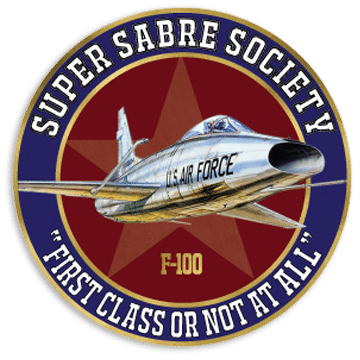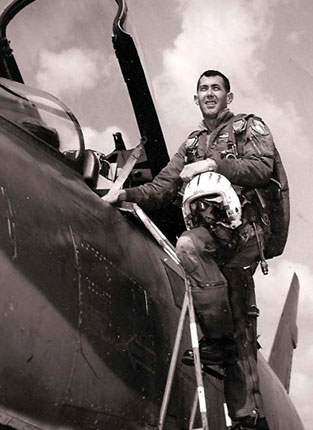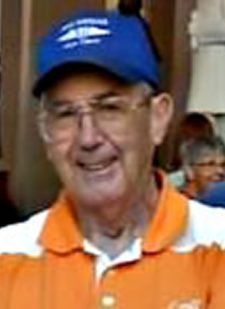A native of Billings, Montana, Johnson was a fighter pilot in the U.S. Air Force and retired in 1986 after 30 years of service.
He was an exalted ruler of the Elks Club in Reno, NV, belonged to the Military Officers Association of America and was a proud member of the River Rats organization(1), the Quiet Birdmen(2), and the Super Sabre Society.
(1)The RED RIVER VALLEY ASSOCIATION (river-rats.org) was founded as a military organization of fighter pilots to commemorate inter-service teamwork, strong esprit de corps, and unprecedented sacrifices demonstrated by American fighting men during the campaign over North Vietnam. The association established Pride of Patriotism and Defense of the Constitution of the United States of America as its guiding principles.
(2) The Quiet Birdmen is a secretive club in the United States for male aviators. Founded in 1921 by World War I pilots, the organization meets in various locations, never announced to the public. Members, called QBs, must be invited to join, and they join for life. Today, the club’s membership, organized into regional “hangars”, is made up primarily of retired airline, military and freight pilots, as well as a few astronauts.[1] It is also known as ye Anciente and Secret Order of Quiet Birdmen. Some notable members include (along with Colonel Johnson), Charles Lindbergh, Eddie Rickenbach, Jimmy Doolittle and Wiley Post.
Barrett V. Johnson, Col USAF. Ret., “Headed West” on January 1, 2013.
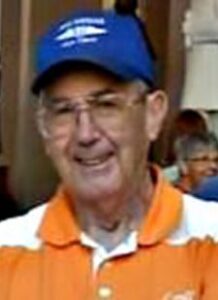 Retired U.S. Air Force Col. Barrett V. Johnson died Jan. 1, 2013, at Tennessee Medical Center in Murfreesboro, following a long battle with idiopathic pulmonary fibrosis.
Retired U.S. Air Force Col. Barrett V. Johnson died Jan. 1, 2013, at Tennessee Medical Center in Murfreesboro, following a long battle with idiopathic pulmonary fibrosis.
A native of Billings, Montana, Johnson was a fighter pilot in the U.S. Air Force and retired in 1986 after 30 years of service. He was an exalted ruler of the Elks Club in Reno, Nev., belonged to the Military Officers Association of America and was a proud member of the River Rats organization, the Quiet Birdmen, and the Super Sabre Society.
He is survived in life by his wife, Sharon K. Johnson, his 2 daughters and his son.
In lieu of flowers, the family requests donations are sent to the Coalition for Pulmonary Fibrosis. For more information about donating to the organization, visit www.coalitionforpf.org.
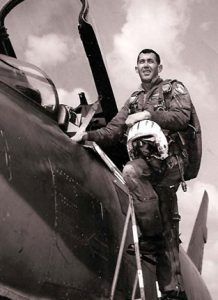 B. V. Johnson – Caterpillar Club
B. V. Johnson – Caterpillar Club
This “un-ass” incident occurred on July 9, 1971, at the Gila Bend Gunnery Complex in Arizona. During this timeframe, I was a Fighter Weapons Instructor at Luke AFB and had happily been flying the Hun for 14 1/2 years. I was assigned to a student who had been grounded for a thyroid operation, he was behind his classmates in the last active duty F-100 RTU class in the USAF.
The F-100 training was being transferred to the ANG at Tucson, AZ. I had finished all the weapons academics for the class and was looking forward to flying with this student twice a day to help him catch up with his class. We accomplished the standard briefing, engine start, taxi and takeoff and proceeded to Range 2 on the gunnery complex. After completing six strafing passes and four 15-degree dive deliveries, we entered the 30-degree dive delivery phase.
On the second dive pass, the student released his bomb, and when he started to pull out, there was a loud explosion in the aircraft. I immediately asked him if he had tried to light the afterburner as he was adding the power, and he said, “Negative.” I saw the “Fire Warning Light,” took control of the aircraft, and started a climbing turn for altitude, heading for the emergency airfield at Gila Bend, 16 miles away.
In my best deep fighter pilot voice, I said, “Range 2, this is Ravage, I’ve got a Fire Warning Light and I’m headed to Gila Bend.” His response in a very calm voice was, “Roger Ravage, you’re on fire!” I looked over my shoulder and observed a very brilliant smoke trail following the aircraft. I looked down in the cockpit and there was an Oil Overheat light and the tailpipe temperature was 800 degrees centigrade.
After getting to near 6,000 feet MSL, I retarded the power to 90 percent and the Range Officer told me the smoke had quit. The engine started to surge, so I pulled the throttle back further, selected the emergency fuel system, re-advanced the throttle to 90 percent and the engine stabilized. So far no sweat, right? I had 90 percent power and the TPT was 600 to 650 degrees, 260 knots at 5,000 feet. I saw the oil pressure was “O” psi, (oh well, I’ve had this before and Gila Bend is only about 10 miles away). Then came AC and DC generator failure, reset….reset…., no change. Then, Utility and Flight System Failure. Utility pressure, O psi, #1 Flight System pressure, O psi. We were still OK, #2 Flight System is 2,800 psi and we’ve got an emergency system for the gear. Shit, I saw the #2 was dropping! I told the student to turn on the RAT…#2 was still dropping.
Mayday!……Mayday!…… I had a Fire Light, zero oil pressure, AC and DC Generators had failed, Utility system was O psi, #1 Flight system was O psi, #2 Flight system is O psi and the flight controls were frozen. And, we were on fire and ejecting 5 miles SE of Gila Bend. I didn’t want any pilot error bullshit to be even thought of.
We stowed all our loose equipment and I initiated the ejection system with my zero lanyard attached. My un-ass experience was not routine, probably because I had the zero lanyard hooked up. I was definitely surprised at how much windblast there was at only 250 knots. I was spinning like a top when the chute deployed with the risers under my left arm and then the risers wrapped around my wrist and I took the opening shock on that one arm. It pulled my arm out of joint, tore off my helmet and shattered my left shoulder blade.
After I got untangled from the risers and got my arm back in the socket, I looked up and wasn’t real happy to see three risers gone and the total skirt of the chute held on by what looked like a very sparse spider web. I figured I was going to experience one of those famous Roman Candles and fall to my death, but the old chute held and I made it to the ground, though the landing was a real crash.
I did manage to deploy the survival kit so I didn’t break any more bones on the landing. Luckily they had just initiated having a rescue helicopter on station at Gila Bend, and Pedro arrived to pickup both of us in about 15 minutes. The rest of the story is pretty routine. We were put in a ward in the Luke Hospital; the student hadn’t deployed his seat kit and had a fracture of his leg. There were 8 guys in the ward, two from an emergency bailout and 6 from motorcycle accidents!
It was interesting that after 14 1/2 years and 3,353 hours in the Hun, I finally had a flight with no landings!!!!
